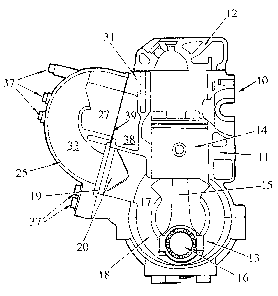Some of the information on this Web page has been provided by external sources. The Government of Canada is not responsible for the accuracy, reliability or currency of the information supplied by external sources. Users wishing to rely upon this information should consult directly with the source of the information. Content provided by external sources is not subject to official languages, privacy and accessibility requirements.
Any discrepancies in the text and image of the Claims and Abstract are due to differing posting times. Text of the Claims and Abstract are posted:
| (12) Patent Application: | (11) CA 2105058 |
|---|---|
| (54) English Title: | MULTICYCLINDER TWO-STROKE ENGINE INTAKE MANIFOLD |
| (54) French Title: | COLLECTEUR D'ADMISSION DE MOTEUR A DEUX TEMPS A PLUSIEURS CYLINDRES |
| Status: | Deemed Abandoned and Beyond the Period of Reinstatement - Pending Response to Notice of Disregarded Communication |
| (51) International Patent Classification (IPC): |
|
|---|---|
| (72) Inventors : |
|
| (73) Owners : |
|
| (71) Applicants : | |
| (74) Agent: | SMART & BIGGAR LP |
| (74) Associate agent: | |
| (45) Issued: | |
| (86) PCT Filing Date: | 1992-03-20 |
| (87) Open to Public Inspection: | 1992-10-01 |
| Examination requested: | 1999-03-04 |
| Availability of licence: | N/A |
| Dedicated to the Public: | N/A |
| (25) Language of filing: | English |
| Patent Cooperation Treaty (PCT): | Yes |
|---|---|
| (86) PCT Filing Number: | PCT/AU1992/000119 |
| (87) International Publication Number: | WO 1992016726 |
| (85) National Entry: | 1993-08-27 |
| (30) Application Priority Data: | ||||||
|---|---|---|---|---|---|---|
|
2105058 9216726 PCTABS00016
A multicylinder two-stroke cycle internal combustion engine (10)
comprises an individual crankcase cavity (18) for each cylinder
to receive the incoming air charge for that cylinder and a
cylinder block (11) with at least two cylinders having co-operating
crankcase cavities (18) provided with valve controlled intake ports
(19) in a common wall (31) of the cylinder block (11). An air
induction manifold (25) is detachably mounted to the common wall (31)
to form a single air induction cavity (27), at least part of
which is formed within the cylinder block (11), and has a single
main inlet port for regulation of air inflow to the induction cavity
(27). Individual passages (33) communicating each crankcase
cavity inlet port (19) with the air induction cavity (27) are formed
in the manifold (25). Acceptable performance with limited
increase in the overall physical dimensions of the engine (10) can thus
be obtained.
Note: Claims are shown in the official language in which they were submitted.
Note: Descriptions are shown in the official language in which they were submitted.

2024-08-01:As part of the Next Generation Patents (NGP) transition, the Canadian Patents Database (CPD) now contains a more detailed Event History, which replicates the Event Log of our new back-office solution.
Please note that "Inactive:" events refers to events no longer in use in our new back-office solution.
For a clearer understanding of the status of the application/patent presented on this page, the site Disclaimer , as well as the definitions for Patent , Event History , Maintenance Fee and Payment History should be consulted.
| Description | Date |
|---|---|
| Inactive: IPC from MCD | 2006-03-11 |
| Application Not Reinstated by Deadline | 2003-11-24 |
| Inactive: Dead - No reply to s.30(2) Rules requisition | 2003-11-24 |
| Deemed Abandoned - Failure to Respond to Maintenance Fee Notice | 2003-03-20 |
| Inactive: Abandoned - No reply to s.30(2) Rules requisition | 2002-11-25 |
| Inactive: S.30(2) Rules - Examiner requisition | 2002-05-23 |
| Inactive: Delete abandonment | 2000-05-02 |
| Deemed Abandoned - Failure to Respond to Maintenance Fee Notice | 2000-03-20 |
| Inactive: Status info is complete as of Log entry date | 1999-03-19 |
| Inactive: Application prosecuted on TS as of Log entry date | 1999-03-19 |
| Request for Examination Requirements Determined Compliant | 1999-03-04 |
| Inactive: RFE acknowledged - Prior art enquiry | 1999-03-04 |
| All Requirements for Examination Determined Compliant | 1999-03-04 |
| Application Published (Open to Public Inspection) | 1992-10-01 |
| Abandonment Date | Reason | Reinstatement Date |
|---|---|---|
| 2003-03-20 | ||
| 2000-03-20 |
The last payment was received on
Note : If the full payment has not been received on or before the date indicated, a further fee may be required which may be one of the following
Please refer to the CIPO Patent Fees web page to see all current fee amounts.
| Fee Type | Anniversary Year | Due Date | Paid Date |
|---|---|---|---|
| MF (application, 6th anniv.) - standard | 06 | 1998-03-20 | 1998-02-24 |
| MF (application, 7th anniv.) - standard | 07 | 1999-03-22 | 1999-02-18 |
| Request for examination - standard | 1999-03-04 | ||
| MF (application, 8th anniv.) - standard | 08 | 2000-03-20 | 2000-02-25 |
| MF (application, 9th anniv.) - standard | 09 | 2001-03-20 | 2001-02-21 |
| MF (application, 10th anniv.) - standard | 10 | 2002-03-20 | 2002-02-18 |
| MF (application, 2nd anniv.) - standard | 02 | 1994-03-21 |
Note: Records showing the ownership history in alphabetical order.
| Current Owners on Record |
|---|
| ORBITAL ENGINE COMPANY (AUSTRALIA) PTY. LIMITED |
| Past Owners on Record |
|---|
| CHRISTOPHER KIM SCHLUNKE |
| CHRISTOPHER NEVILLE FRANCIS SAYER |
| KENNETH PHILLIP SEEBER |
| RODNEY ALEXANDER ROWNEY HOUSTON |